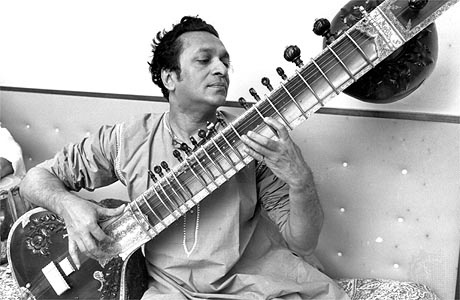sitar
musical instrument
 stringed instrument of the lute family that is popular in northern India, Pakistan, and Bangladesh. Typically measuring about 1.2 metres (4 feet) in length, the sitar has a deep pear-shaped gourd body; a long, wide, hollow wooden neck; both front and side tuning pegs; and 20 arched movable frets. Its strings are metal; there are usually five melody strings, one or two drone strings used to accentuate the rhythm or pulse, and as many as 13 sympathetic strings beneath the frets in the neck that are tuned to the notes of the raga being played. The convex metal frets are tied along the neck, which enables them to be moved as needed. The sitar often has a resonating gourd under the pegbox end of the neck; this balances the weight of the instrument and helps support it when it is not being played. The musician, who holds the sitar at a 45° angle on his lap while seated, plucks the strings with a wire plectrum worn on the right forefinger while the left hand manipulates the strings with subtle pressure on or between the frets and with sideways pulls of the strings.
stringed instrument of the lute family that is popular in northern India, Pakistan, and Bangladesh. Typically measuring about 1.2 metres (4 feet) in length, the sitar has a deep pear-shaped gourd body; a long, wide, hollow wooden neck; both front and side tuning pegs; and 20 arched movable frets. Its strings are metal; there are usually five melody strings, one or two drone strings used to accentuate the rhythm or pulse, and as many as 13 sympathetic strings beneath the frets in the neck that are tuned to the notes of the raga being played. The convex metal frets are tied along the neck, which enables them to be moved as needed. The sitar often has a resonating gourd under the pegbox end of the neck; this balances the weight of the instrument and helps support it when it is not being played. The musician, who holds the sitar at a 45° angle on his lap while seated, plucks the strings with a wire plectrum worn on the right forefinger while the left hand manipulates the strings with subtle pressure on or between the frets and with sideways pulls of the strings.The word sitar is derived from the Persian word sehtar, meaning “three-stringed.” It appears to have descended from long-necked lutes taken to India from Central Asia. The sitar flourished in the 16th and 17th centuries and arrived at its present form in the 18th century. Today it is the dominant instrument in Hindustani music; it is used as a solo instrument with tamboura (drone-lute) and tabla (drums) and in ensembles, as well as for northern Indian kathak (dance-dramas). Two modern schools of sitar playing in India are the Ravi Shankar (Shankar, Ravi) and Vilayat Khan schools, each with its own playing style, type of sitar used (varying in size, shape, number of strings, etc.), and tuning system.
Worldwide, the instrument has become the best known of the South Asian lutes. In the 1960s the sounds of South Asian instruments, especially the sitar, influenced a number of rock performers. George Harrison, the lead guitarist of the Beatles (Beatles, the), studied the sitar and played the instrument on several songs, beginning with "Norwegian Wood" (1965). Other musicians of the period imitated sitar sounds on the guitar; some used an electric “sitar” that modified the instrument for ease of performance but preserved its primary tone colour. In the early 21st century Shankar's daughter Anoushka became a prominent sitar player who joined with musicians from around the world to perform and record original music based on Hindustani principles.
- Gamaliel I
- Gamaliel II
- Gamaliel III
- Gama, Vasco da
- Gambaga Scarp
- Gambetta, Léon
- Gambia, flag of The
- Gambia River
- Gambia, The
- Gambier Islands
- Gambino, Carlo
- gambling
- Gamboa
- gamboge
- Gamburtsev Mountains
- game
- gamelan
- Gamelin, Maurice
- gamete
- game theory
- gametophyte
- gaming, Indian
- gamma decay
- gamma function
- gamma globulin